Farro has taken Portland, Oregon by storm. I see it on menus all over town:
- Aviary: Hoisin-Glazed Short Rib with Farro, Turnips & Yuzu Pickles.
- Bluehour: Farro Risotto with Pumpkin, Wild Mushrooms & Brussels Sprouts.
- Clarklewis: Kingfisher Salad with Bluebird Farm Farro, Hedgehog Mushrooms, Persephone Cipollini & Whole Mustard Vinaigrette.
- Clyde Common: Roasted Duck with Farro, Pomegranate, Swiss Chard, & Blood Orange.
- Cocotte: Pullet En Cocotte with Farro, Winter Vegetables, Poached Farm Egg & Sherry Jus.
- DOC: Frittata with Farro, Broccoli, Turnip, Tahonohono & Hedgehog.
- Laurelhurst Market: Bluebird Grains Emmer Farro with Fennel & Crème Fraiche.
- Nel Centro: Braised Lamb Shank with Butternut Squash & Black Kale Farro.
- Roost: Braised Pork with Bacon Farro, Turnips and Greens.
- Wildwood: Toasted Farro & Baby Turnip Stuffed Cabbage.
I’m a little late to the party, this being only my third farro post to date, but I plan to make up for it in the months ahead. We have fallen in love with the nutty flavor and chewy texture of this crazy-good-for-you grain, and like the rest of Portland at the moment, can’t seem to get enough of it.
Most sources say that farro (pronounced FAHR-oh) is an ancient type of wheat. But you may also find sources that say that farro is not wheat at all. And this is only the beginning of the confusion I encountered on the web with a search on the words farro and spelt. Holy moly!
However, everyone seems to agree that farro contains twice the protein and fiber of modern (common) wheat, making it the new darling of vegetarians and nutritionists alike.
The terms farro and spelt are often used interchangeably, and although they belong to the same genus, they are different species. With widespread confusion over naming, it can be difficult or impossible to tell which type of whole wheat berry any package or bin actually contains.
My research revealed the following clear distinctions between the three types of ancient wheat berries (as opposed to modern/common wheat berries). When in doubt, look for the name of the genus and species (italicized below) on the packaging.
- einkorn wheat / farro piccolo / little farro (Triticum monococcum)
- emmer wheat / farro medio / true farro (Triticum dicoccum)
- spelt wheat / farro grande / spelt / false farro (Triticum spelta)
Einkorn wheat berries (farro piccolo) boost several distinctions. They are the smallest grain in the farro classification. They are also the oldest and rarest of Italian cultivated grains, dating back at least 10,000 years. Anson Mills claims that it is the only grower of einkorn wheat in the United States. Light in color and character, einkorn wheat berries are a good summer grain. They cook quickly and have a flavor somewhat lighter than emmer wheat berries. Imported einkorn wheat berries are often mislabeled as true farro, which is another name for emmer wheat berries. You should be able to distinguish einkorn wheat berries because of their markedly smaller size.
Emmer wheat berries are the queen of ancient wheat and are the most common variety grown in Italy today. They are prized for their full nutty flavor and delightfully chewy texture. It is very difficult to tell them apart visually from spelt or common wheat berries.
Spelt wheat berries seem to be the least admired of the three types of farro berries, and I have not cooked with them enough to give you my two cents worth. On the web, there are cooks aplenty bemoaning the fact that their spelt berries never softened sufficiently to eat. However, spelt is highly nutritious and prized by whole grain bakers in its flour form.
And then we also have the following two wheat berries, which have a similar flavor and texture profile as farro:
- common wheat / cultivated wheat (Triticum aestivum)
- khorasan wheat / Kamut / (Triticum turanicum)
Perhaps the most important thing for the cook to note is that each of these wheat berries requires slightly different preparation and cooking time, and authoritative sources give conflicting information. For best results, read and follow the preparation directions on the package.
Depending on the recipe, you may be able to substitute einkorn wheat berries, spelt wheat berries, common wheat berries, or Kamut for emmer wheat berries, but BE AWARE that cooking time, liquid absorption rate, texture, and flavor will vary (perhaps considerably) from one to the other.
This said, I rely almost solely on Bluebird Grain Farms Emmer Farro for predictable and perfect results every time. It is grown by Brooke and Sam Lucy on their farm in Washington’s Methow Valley. They have developed their own process for removing the husk from the grain, which keeps the integrity and nutrition value of the grain intact. Northwest chefs are enamored with this grain and often prefer it over farro that is imported from Italy.
Preparing Farro (All Types)
For best results, cover farro with cold water, cover with plastic rap or a lid, and let hydrate 4 to 24 hours. After soaking, drain, rinse, cover with fresh water (or stock), and simmer for 30-60 minutes, until tender and pleasantly chewy. The hydrated berries will plump to twice their original size.
Three cups of dry farro will yield about 7½ cups of cooked grain.
You can freeze prepared berries in 2-cup increments for later use. This process works equally well for common wheat berries and kamut.
Farro, Wild Mushroom, Fingerling Potato & Kale Risotto (Farrotto)
What a marvelous flavor and texture juxtaposition this is: chewy, velvety, creamy, crunchy, earthy, cheesy, and delicious. Farrotto, you are my new whole grain love!
Unlike Arborio rice, farro releases only a small amount of starch when cooked and never becomes gummy. Thus you don’t have to stir Farrotto constantly, as you do risotto.
It also retains a tender, distinct bite, even when not served immediately.
2 cups soaked emmer farro (from 1½ cups dry emmer farro)
3 tablespoons unsalted butter
2 cups chopped leek (white and pale green portion only)
2 large cloves peeled garlic, pressed or minced
½ cup dry white wine
3-4 cups vegetable or chicken stock
8 ounces crimini, shiitake, oyster or other wild mushrooms, cleaned and quartered
12 ounces tiny fingerling potatoes, scrubbed and halved lengthwise
large handful lacinato kale, roughly chopped
1 tablespoon unsalted butter
¼ cup finely grated Parmigiano Reggiano
¼ cup finely grated Pecorino Romano
½ teaspoon fine sea salt, plus more to taste
Finishing
¼ cup finely grated Parmigiano Reggiano
freshly grated black pepper
- Put farro in a large mixing bowl and cover with cold water. Let hydrate for 6-24 hours. Drain and measure out 2 cups.
- In a large sauté pan with a tight fitting lid, melt 3 tablespoons butter, and cook the leeks and garlic until softened, about 10 minutes.
- Add white wine, and reduce by half.
- Add the farro and 2 cups stock. Cover and simmer slowly for about 20 minutes, until most of the stock is gone, and the farro is chewable. (Don’t worry about taking the farro too far here; it retains its chewiness even with prolonged cooking.)
- Add the mushrooms, potatoes, and 1 cup additional stock. Cover and cook at a lively simmer for about 10 minutes, until veggies are just tender. If the liquid evaporates before the potatoes are tender, add additional stock in ½ cup increments.
- Add the kale and rosemary, and stir to wilt the kale.
- If necessary, simmer rapidly to reduce the liquid somewhat. (Don’t reduce too much. You don’t want a dry risotto. The cheese will thicken the remaining liquid considerably.)
- Remove from the heat, and add the remaining 1 tablespoon butter. Swirl it into the liquid, to emulsify rather than melt it.
- Add the cheeses, toss, and then add salt to taste.
- Serve immediately with additional cheese and freshly grated black pepper.
LunaCafe Farro & Kamut Recipes
- Kamut, Kale & Cabbage Soup with Winter Pistou
- Northwest Early Spring Farro & Lentil Salad
- Smoky Spanish Zarzuela with Chorizo & Emmer Farro
More Farro Recipes
- 101 Cookbooks: Farro Recipes
- 101 Cookbooks: Simple Farro & Bean Stew
- Closet Cooking: Lamb and Mint Meatballs with Farro Risotto and Cilantro Pesto
- Food Network: Farro Salad with Tomatoes and Herbs
- Joy the Baker: Roasted Tomato and Caramelized Onion Salad
- Lisa’s Kitchen: Mexican-Style Kamut Berry, Black Bean and Roasted Corn Salad
- New York Times: Farro with Mushrooms
- Nourish Network: 15 Minute Farrotto with Sage and Butternut Squash
- Orangette: Its Name is Farro
- PD: Feasting on Farro: Ten Delicious Recipes for Winter
- Smitten Kitchen: Mushroom and Farro Soup
- The Savory Notebook: Mushroom Wheat Berry Pilaf
Resources
- Eat This: Wheat, Kamut & Spelt Berry 101
- eHow: What is Kamut Used for?
- Farro, an Old Italian Favorite Returns
- Jovial: Einkorn History / Timeline
- Jovial: Einkorn Wheat Berries are in
- Kamut: Ancient Grain, New Cereal
- Mix Magazine: Good for You: Plow-to-Plate Grains with an Old World Pedigree
- New York Times: Farro, Italy’s Rustic Staple: The Little Grain that Could
- Portland Monthly: How Farro We’ve Come
- Recipe Tips: Types of Grain
- Roots and Grubs: Amber Waves
- The Atlantic: Fresh Recipes with an Ancient Grain: 4 Ways to Prepare Fresh Farro
- The Foozie Blog: Whole Grain Farro 101
- The New York Times: Farro, Italy’s Rustic Staple: The Little Grain that Could
- The New York Times: Grain Exchange
- Wikipedia: Einkorn Wheat
- Wikipedia: Emmer
- Wikipedia: Farro
- Wikipedia: Spelt
- Wise Geek: What is Farro?
Suppliers
- Anson Mills (farro piccolo (einkorn) and slow-roasted farro grande [spelt])
- Bluebird Grain Farms (emmer farro)
- Bob’s Red Mill (organic Kamut berries)
- Bob’s Red Mill (whole grain spelt berries)
- ChefShop (Eastern Washington Lentz Farms organic emmer farro)
I Love Hearing from You!
Please leave a comment. Include your blog URL so CommentLuv will automatically link to your most recent blog post. And join me at LunaCafe on Facebook for daily adventures in the OtherWorldly Kitchen. Let’s get cooking! …Susan
Copyright 2012 Susan S. Bradley. All Rights Reserved.

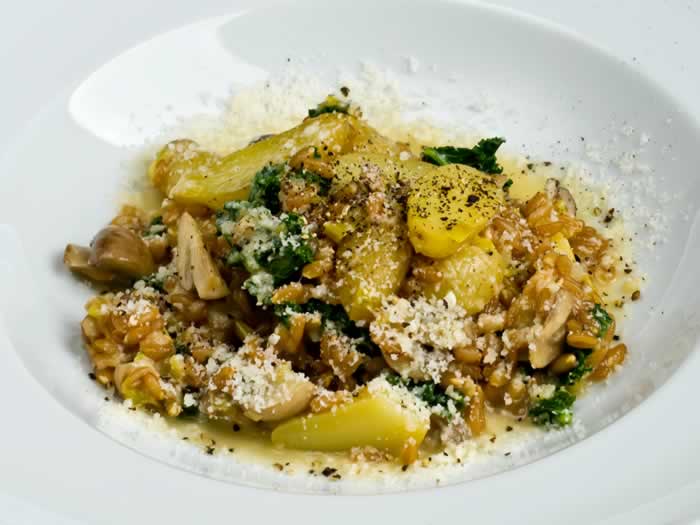
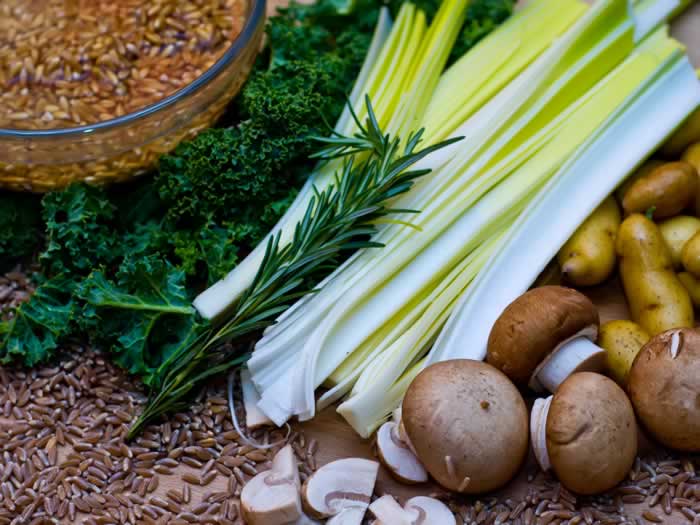

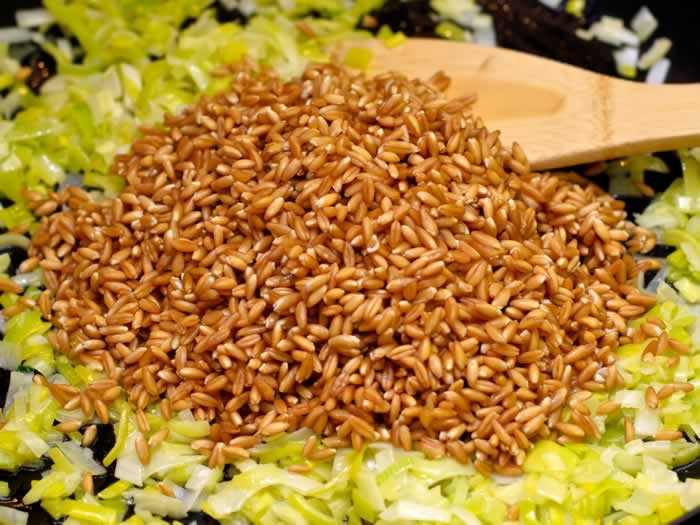


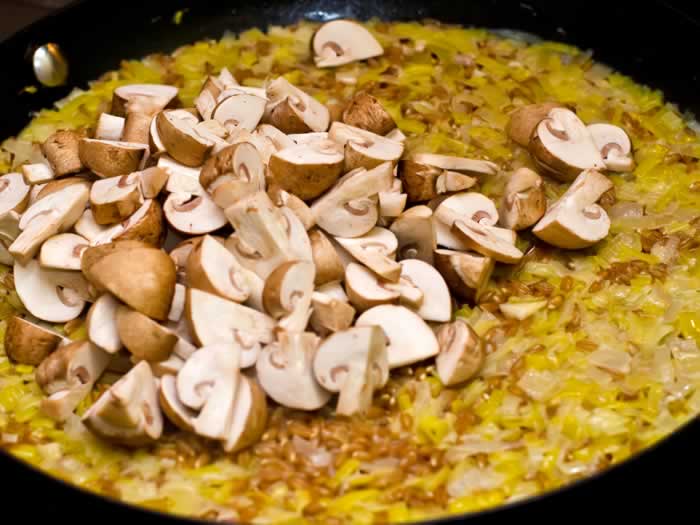
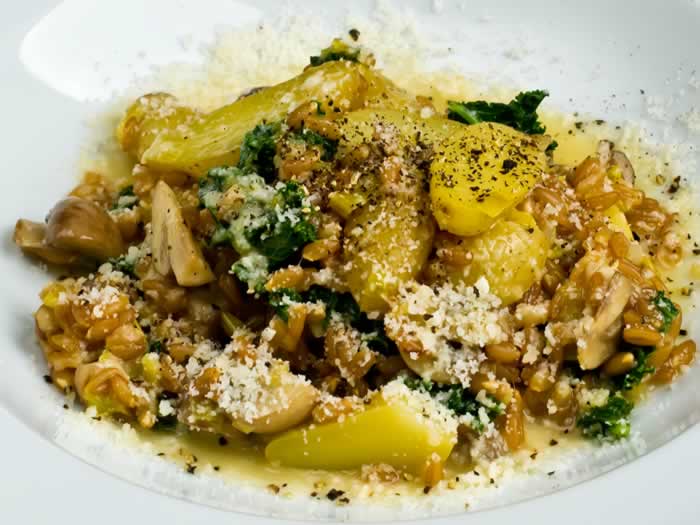
The farro is a very interesting use in this risotto. I will have to try this sometime. thx for sharing.
Please tell me what is different ferro and kamut berry.
This looks really good!
Hi Susan. I am originally from Southern Ca and now reside in Nashville, TN, and love the Pacific Northwest. I am SO entrigued by your recipes and blog page, and also your cookbook, but have a question regarding that. Have you written one or two cookbooks or is it the same one with one having a hard cover and one a soft. I am interested in the hardcover book, so where is the best place for me to get that, preferrably new?
Thanks so much, Susie Klein
Hi Susie and thank you! It’s one cookbook with two printings, one hardcover, one softcover. The book is out of print, but you can occasionally find a copy on Amazon or in a used bookstore. We are thinking of making the recipes available on LunaCafe. Best…Susan
This is a great write-up. Thanks a ton for taking the time to explain all this out for us. It is a great help!
I’m afraid to admit that I’ve never had farro! But I adore risotto and this might be just the dish to tempt me into trying it
Feast, you are about to be WOWED. 🙂 Two years ago, I started with one small bag of farro. Now there is a large jar of it next to the equally large jar of Arborio rice. I have a Wild Mushroom and Farro Soup coming that I think you will love.
I think BlueBird Grain Farms has a lot to do with why farro is all over the menus in Seattle and Portland! Their farm is organic and salmon-safe, and I think chefs are looking for that. You can see their farm at the beginning of this video about the salmon safe program: http://www.salmonsafe.org/blog/new-TU-video. I’ve used their farro, too, and like it. I’ve never soaked it, just cooked it like brown rice. It is chewy but I like it fine that way.
Thanks, Mary! I “discovered” Bluebird Grain Farms at the Seattle University Farmers Market a couple of years ago. I balked at the price the first time I bought it, but never again. You’re right, you don’t have to soak it. I have found with other bulk emmer farro though, that soaking gives more predictability in timing the cooking process. On a side note, I just finished the last of a fabulous wild mushroom and farro soup last night and after 5 days in the fridg, the farro was still chewy and nicely firm. I love that about it!